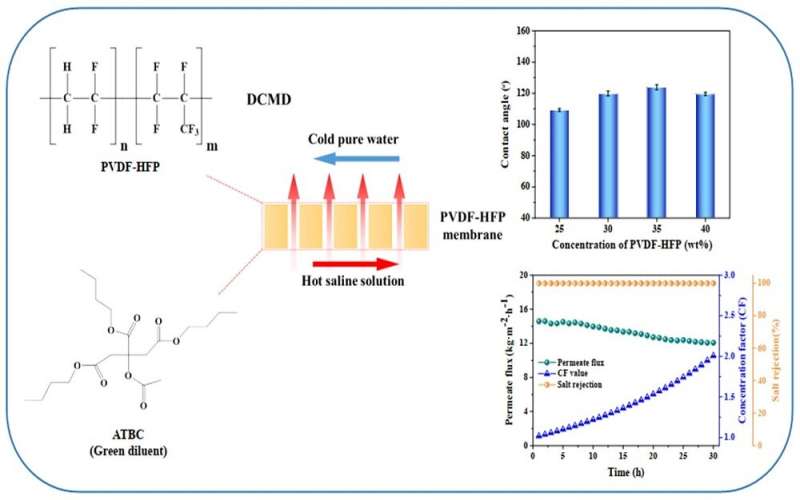Credit: Jun Pan et al, Frontiers of Chemical Science and Engineering (2022)
As many chemists know, the membrane distillation (MD) process has gained increasing popularity and attention for saline treatment, especially because of its extremely high salt rejection (the theoretical value up to 100%). In MD, the hydrophobic membrane serves as a core and significant part of realizing two-phase separation. However, the existing membrane wetting phenomenon always restricts the long-term stable operation and separation efficiency.
Zhaoliang Cui, a professor from the College of Chemical Engineering of Nanjing Tech University, and colleagues have found one promising solution to solve this problem by preparing hydrophobic poly(vinlidene fluoride-co-hexafluoro propylene) (PVDF-HFP) copolymer membrane to improve surface hydrophobicity. Their study was published online in Frontiers of Chemical Science and Engineering on March 28, 2022.
In this study, one hydrophobic fluorinated polymer material, PVDF-HFP, was chosen as the membrane material to prepare porous membrane for membrane distillation application. The thermally induced phase separation (TIPS) method was employed to prepare the membrane, which is a common fabrication method. In order to decrease harm from the volatilization of used solvent at a high temperature during the TIPS process, the green and environmentally friendly diluent acetyl tributyl citrate (ATBC) was used.
According to the phase diagram of PVDF-HFP/ATBC system, there was a wide liquid-liquid phase region among the range of prepared polymer concentrations (25-40 wt%), indicating that a liquid-liquid phase separation occurs. As a result, a final bi-continuous structure can be obtained. The pore connectivity, permeability and mechanical properties of such a structure will benefit the mass transfer during the separation process. The surface contact angle, porosity, tensile strength and elongation at breaks of the prepared membranes in this study were up to 123.87o, 60.43%, 5.89 MPa and 396.85%, respectively.
Then the prepared PVDF-HFP membranes were applied in the membrane distillation process treating 3.5 wt% NaCl saline. Firstly, the base desalination performance was tested at different feed temperatures, which showed that the permeate flux remained proportional to the feed temperature. This is consistent with common knowledge. Moreover, for a longer testing period, the prepared membrane had a stable membrane distillation flux and was not wetted (the permeated conductivity was always around 2–3 mS·cm−1). These are all exciting and satisfying results.
Cui and his team will continue their study on the preparation of hydrophobic or super-hydrophobic membranes for membrane distillation applications. They hope to prepare enough functional hydrophobic membranes to achieve the final goal of zero liquid discharge of wasted saline to be able to recycle the industrial raw materials and water resources.
More information: Jun Pan et al, Poly(vinylidene fluoride-co-hexafluoro propylene) membranes prepared via thermally induced phase separation and application in direct contact membrane distillation, Frontiers of Chemical Science and Engineering (2022). DOI: 10.1007/s11705-021-2098-y
Provided by Higher Education Press
























